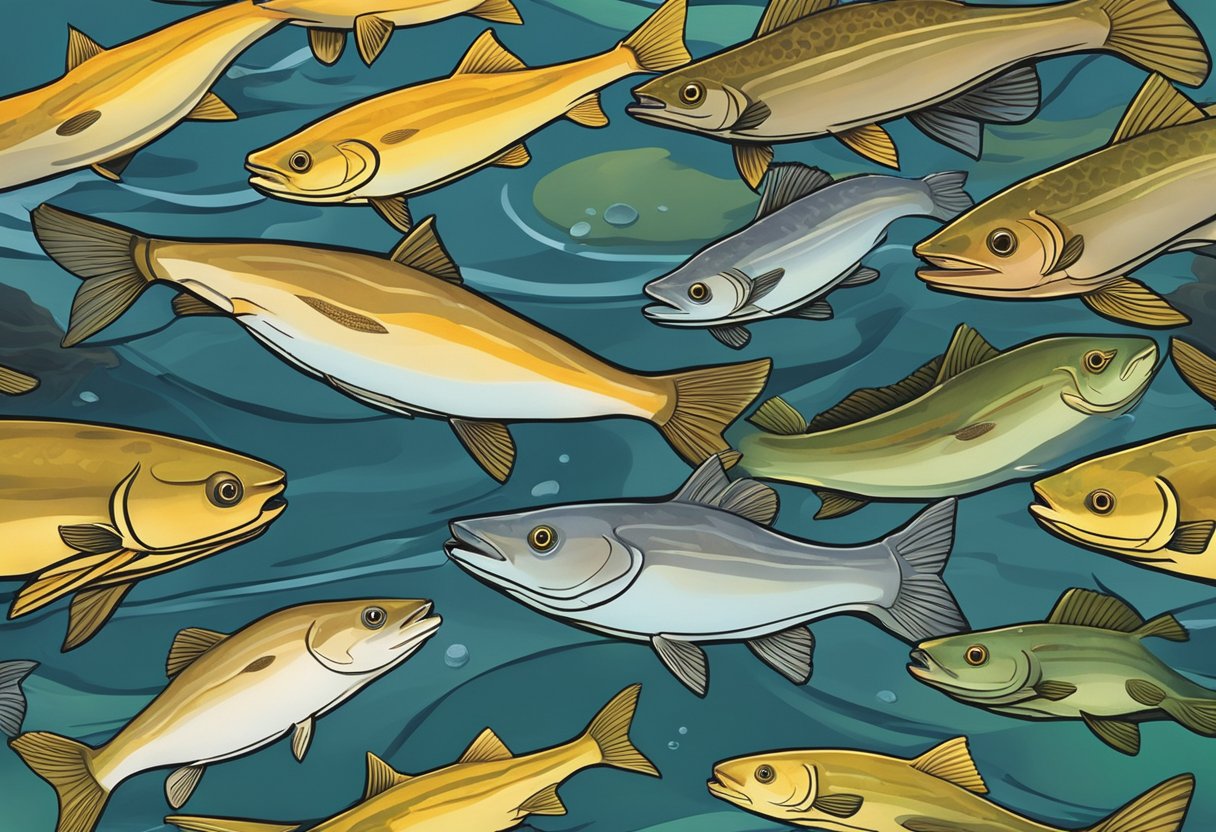Types Of Catfish
Catfish are a diverse group of fish that are found all over the world. There are over 3,000 species of catfish, and they can be found in freshwater, saltwater, and brackish water habitats. These fish are known for their distinctive barbels, which are sensory organs that help them locate food in murky water.
The physical characteristics of catfish vary widely depending on the species. Some catfish have a flattened head that allows them to dig through the substrate, while others have a cylindrical body with a flattened ventrum to facilitate benthic feeding. The most sought-after species of catfish in the United States are the blue, channel, and flathead catfish. These fish have distinct physical characteristics that make them easy to identify.
Key Takeaways
- Catfish are a diverse group of fish found in freshwater, saltwater, and brackish water habitats.
- Catfish have distinctive physical characteristics, including barbels and flattened heads or ventrums.
- The most popular species of catfish in the United States are the blue, channel, and flathead catfish.
Diversity of Catfish Species

Catfish are a diverse group of fish that belong to the order Siluriformes. There are over 3,000 species of catfish worldwide, with 40 types of catfish families in the world, and 30 in the United States alone. One out of every 20 known vertebrate animals is a catfish, making it an extremely high ratio.
North American Native Species
The Ictaluridae family includes 51 North American catfish species, such as the channel catfish, blue catfish, and flathead catfish. The channel catfish is the most common and widely distributed species of catfish in North America. It can be found in every state in the contiguous United States, as well as parts of Canada and Mexico. The blue catfish is the largest species of North American catfish and can grow up to 5 feet in length and weigh over 100 pounds. The flathead catfish is a popular game fish and can be found in rivers and lakes throughout the eastern United States.
Other native North American species of catfish include the white catfish, which is found in the Atlantic coastal waters, and the bullhead catfish, which is found in the Great Lakes region.
Exotic and Invasive Species
There are also many exotic and invasive species of catfish that have been introduced to North America. One example is the wels catfish, which is native to Europe and Asia and has been introduced to several North American waterways. Another example is the pictus catfish, which is native to South America and has become established in several southern states.
Invasive species of catfish can cause significant ecological damage by outcompeting native species for resources, altering food webs, and transmitting diseases. The Mekong giant catfish, native to Southeast Asia, is considered an invasive species in some areas and can grow up to 10 feet in length and weigh over 600 pounds.
Overall, the diversity of catfish species is vast and varied, with each species possessing unique characteristics and adaptations that allow them to thrive in their respective environments.
Physical Characteristics
Defining Features
Catfish are known for their unique physical features that distinguish them from other fish species. They have a flattened head, a broad mouth, and a long, slender body covered in slimy skin. Most species of catfish have a set of barbels or whiskers around their mouth, which they use to locate food in murky waters. These barbels are highly sensitive to touch and taste and help the catfish to identify their prey.
The anal fin of a catfish is located near the tail and is used for stability and steering. Some species of catfish have a spine on their dorsal fin, which can be used for protection against predators. The body of a catfish is covered in scales or bony plates that provide additional protection.
Size and Growth
Catfish vary in size depending on the species. The smallest species of catfish are less than an inch long, while the largest species can grow up to 10 feet long and weigh over 100 pounds. The world record for the largest catfish caught is 646 pounds, caught in Thailand in 2005.
Catfish can grow rapidly and can reach maturity within a year or two. They are opportunistic feeders and can consume a variety of food items, including insects, smaller fish, and even other catfish. Catfish can live for several years and continue to grow throughout their life.
In terms of coloration, catfish can come in a range of colors, including white, yellow, brown, gray, and black. Some species, such as the black bullhead, have a dark black coloration. The forked tail of a catfish is another defining feature that helps to distinguish them from other fish species.
Overall, catfish are fascinating creatures with unique physical features that help them to thrive in their natural habitat.
Habitat and Distribution
Freshwater Habitats
Catfish are found in almost every freshwater habitat on earth, from slow-moving rivers and murky swamps to clear mountain streams and deep lakes. They prefer habitats with sand or gravel bottoms, and tend to stay in shallow water. Catfish are also commonly found in reservoirs, where they can thrive due to the abundance of food and shelter.
Geographical Spread
Catfish are found all over the world, but some regions have a higher concentration of species than others. North American catfish, for example, are found primarily in the southeastern United States, with the Mississippi and Rio Grande rivers being popular habitats. In the eastern and southeastern regions of Asia, catfish are also commonly found.
South America is home to a vast array of catfish species, with many of them being unique to the region. The Amazon basin is particularly rich in catfish species, with over 400 species found in the area. The Chesapeake Bay in the United States is also home to several catfish species, including the channel catfish.
In conclusion, catfish are a diverse group of fish that can be found in a variety of freshwater habitats around the world. They prefer habitats with sand or gravel bottoms, and tend to stay in shallow water. While they are found all over the world, some regions have a higher concentration of species than others.
Feeding Habits and Prey
Dietary Variety
Catfish are opportunistic feeders that will eat a wide variety of prey. They are known to feed on invertebrates such as crayfish, mussels, and worms, as well as small fish and algae. Some species are bottom-dwelling and feed on scavenged food, while others are active predators that hunt their prey.
Different species of catfish have different dietary preferences. For example, channel catfish are known to eat fish, insects, snails, small birds, crustaceans, and even vegetation. Blue catfish, on the other hand, are opportunistic predators that feed on a variety of prey including fish, crustaceans, and mollusks.
Hunting Techniques
Catfish use a variety of hunting techniques to catch their prey. Some species, such as the African suckermouth catfish, have a suckermouth that allows them to anchor themselves to rocks and other substrate in fast-moving waters. This technique helps them to catch prey that is swept downstream by the current.
Other species of catfish are nocturnal and use their highly sensitive barbels to locate prey in the dark. They may also use their sense of smell to detect live bait and other food sources. Live bait is a popular choice for anglers looking to catch catfish, as it mimics the natural movement and scent of prey.
In summary, catfish are versatile predators that will eat a wide variety of prey. Their hunting techniques and dietary preferences vary depending on the species and their environment. Understanding these factors can help anglers to choose the right bait and catch more fish.
Catfish in Human Culture
Catfish are a popular fish species that have been a part of human culture for centuries. They are widely known for their unique appearance, size, and taste. In this section, we will explore the different ways that catfish have impacted human culture, including fishing, aquaculture, conservation, and ecological impact.
Fishing and Aquaculture
Catfish are a popular sport fish and are commonly targeted by anglers in North America, particularly in states such as Texas, Missouri, and Ohio. They are known for their strong fighting ability and can grow to impressive sizes, making them a challenging catch.
Catfish are also an important aquaculture species, with farms located across the world, including in Mexico and Northern Guatemala. They are bottom feeders and can be raised in ponds and tanks, making them a relatively easy species to farm.
Conservation and Ecological Impact
Catfish populations have been impacted by overfishing and the introduction of invasive species. In some areas, catfish have become a delicacy and are heavily targeted by commercial fisheries, leading to declines in their populations.
Additionally, the introduction of non-native catfish species, such as the Ictalurus punctatus in Europe, has had negative ecological impacts on native fish populations. These catfish have been known to outcompete native fish for resources and have been linked to declines in native fish populations.
In conclusion, catfish have played an important role in human culture, serving as both a sport fish and a valuable aquaculture species. However, their populations have been impacted by overfishing and the introduction of invasive species, highlighting the need for responsible management practices to ensure their continued existence.






